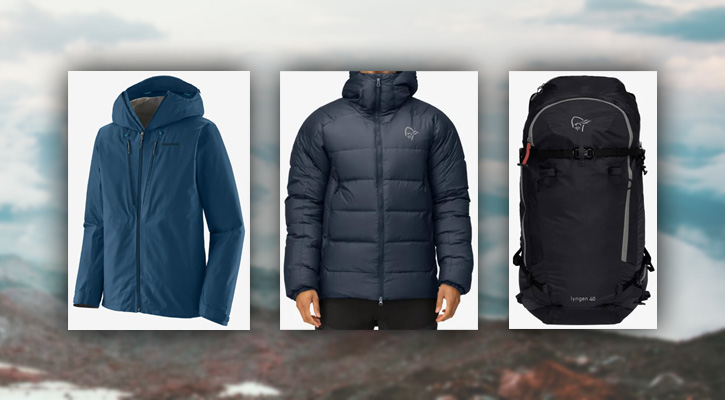
Norrøna and Patagonia are two leading outdoor gear brands with a focus on sustainability. Both companies have an interesting history.
Norrøna was started in 1929 when a Norwegian man wanted to make durable gear for the challenging conditions in Norway.
Patagonia began in 1973 after an American climber started making climbing gear and later expanded to outdoor clothing.
In this article, we’ll compare the quality, materials, features, and prices of each brand to see which could be better for your specific needs.
Contents:
1. Norrøna Outdoor Gear
History of the Brand
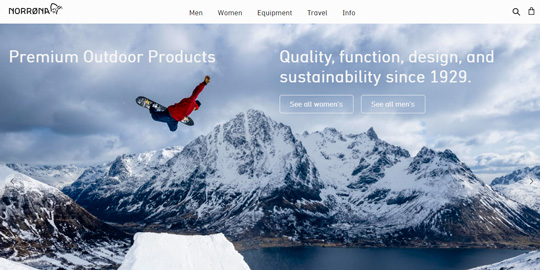
Norrøna official website
In 1929, Norwegian outdoor enthusiast Jørgen Jørgensen embarked on a quest to find durable outdoor gear suitable for Norway‘s challenging conditions. This marked the beginning of Norrøna as he began crafting simple items such as canvas backpacks, leather items, and cotton clothing.
In 1948, Bjarne Jørgensen, the second generation Jørgensen, assumed leadership of the company. Over the years, Norrøna broadened its product range and shifted its focus to technical functionality and mountain equipment.
In 1971, Ole Jørgen Jørgensen, the third generation Jørgensen, took the lead. Additionally, engineer Tomas Carlstrøm was recruited to aid in the development of backpacks and mountain tents.
Throughout the 1970s and 1980s, Norrøna gained popularity for innovative products and supporting expeditions. Key milestones included the introduction of the first tunnel tent in 1972, Europe’s first Gore-Tex jacket in 1977, and supplying gear for the first winter ascent of Trollveggen in 1979.
Design became Norrøna’s third cornerstone in 2000, with a focus on Loaded Minimalism, emphasizing clean, functional design. International expansion commenced in the mid-2000s, with new collections and stores opening in Europe and North America.
In 2015, sustainability was incorporated as Norrøna’s fourth cornerstone. The company is committed to transparency and allocates 1% of sales to environmental causes.
Today, four generations later, Norrøna remains a family-owned company based in Norway. Under the current management of Jørgen Jørgensen, they persist in innovating technical outdoor gear rooted in Norwegian traditions.
Don’t miss:
9 Brands like Norrøna: Our Best Alternatives
Haglöfs vs Norrøna: Which is Better for Outdoor Gear?
Materials, Fabrics, and Production Process
Norrøna prioritizes the use of high-performance, sustainable materials in its product line. They are at the forefront of incorporating eco-friendly fabrics such as organic cotton, recycled polyester and nylon, and down insulation that adheres to the Responsible Down Standard (RDS).
Also, they employ Bluesign-approved fabrics, demonstrating their commitment to transparency and sustainability. Norrøna is recognized for utilizing 100% organic cotton and excels in the use of recycled polyester.
The company actively participates in initiatives like the Fashion for Good organization to promote sustainability and operates a 1% for Nature program, donating a portion of its annual sales to environmental causes and organizations dedicated to preserving nature.
Emphasizing full transparency in their sourcing and manufacturing processes, sustainability stands as a fundamental pillar of Norrøna’s business ethos. Their dedication to developing technical products while prioritizing eco-friendly materials and minimizing environmental impact underscores their commitment to both performance and the planet.
This steadfast approach is evident in their leadership in sustainable outdoor apparel and gear.
Like other leading outdoor brands, Norrøna leverages innovative fabric technologies and materials, including various options of Gore-Tex membranes, Polartec performance fabrics, and PrimaLoft synthetic insulation.
The natural down utilized for insulation originates from the mountains of the Pyrenees in France, and the treatment of birds aligns with high European standards.
The video will be loaded from YouTube.com, a third party. If you play it, you accept their terms of service, and their use of cookies.
Read also: Norrøna vs Arc’teryx Women’s Ski Jackets: Which Brand To Choose?
Where is Norrøna outdoor gear made?
Norrøna manufactures its outdoor gear in various factories across Europe and Asia. Currently, the brand utilizes production facilities in Lithuania, Spain, Portugal, Denmark, and Sweden in Europe, as well as in Vietnam, China, and Thailand in Asia. (source)
Recommended Products
Norrøna trollveggen down 850 Men’s Jacket
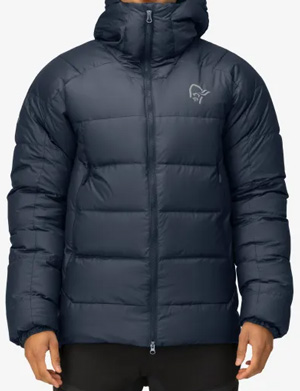
Image: norrona.com
Check it out at Norrona.com
The trollveggen down 850 men’s jacket is a high-quality mountaineering down jacket crafted with aeroDownproof face fabric and packed with RDS-certified 850+ fill power down for superb insulation without adding extra weight.
It includes windproof Pertex Quantum 30D 100% recycled polyester face fabric, 100g PrimaLoft Gold insulation in the pockets and on the shoulders, convenient hand warming pockets, an insulated hood, and an extended back length for added protection.
Read also: 10 Norwegian Jackets and Clothing Brands that You’ll Love
Norrøna lyngen 40L Pack
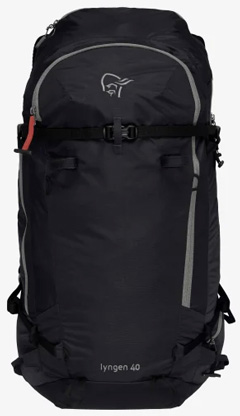
Image: norrona.com
Check it out at Norrona.com
The lyngen 40L pack is a sturdy and lightweight backpack specifically crafted for ski touring, mountaineering, and trekking. Built from robust ECONYL® material using closed-loop regeneration processes, this pack is highly water-resistant and features top-notch YKK zippers.
It boasts a well-ventilated back with an open-back design and various compartments for avalanche gear, crampons, and ropes. Additionally, it’s tailored to transport ski and snowboard equipment and comes with practical elements such as ice ax attachments, compression straps, a hip belt with a pocket, and a chest strap.
The adjustable shoulder straps are designed with a 3D construction to improve breathability.
Read also: 3 Best Norwegian Backpack Brands: Our Top Picks
Prices
Norrøna produces durable and comfortable outdoor equipment with the best materials to endure demanding activities. Customer reviews report achieving peak performance even in the harshest environments due to Norrøna’s engineering and design.
However, the initial investment is not easily affordable for most people, with their jackets priced between $300 and over $1000, and their backpacks ranging from $100 to $700.
Are Norrøna products worth the price?
We’re of the opinion that Norrøna’s jackets and outdoor equipment offer excellent value for money for advanced outdoor pursuits. The brand offers cutting-edge technology with its jackets, for warmth and comfort, as well as vibrant designs not commonly found in other brands.
Having said that, for those preferring casual outdoor activities or trying a new outdoor sport, Norrøna may be too expensive.
Learn more: Why is Norrøna so Expensive? Are Their Jackets Worth It?
2. Patagonia Outdoor Gear
History of the Brand
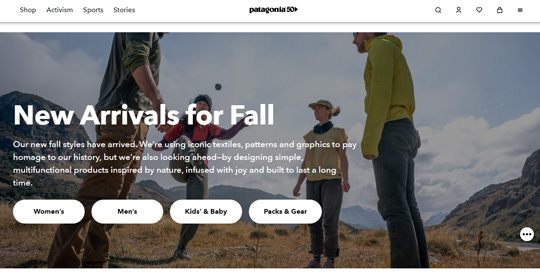
Patagonia official website
The origins of Patagonia can be traced back to 1957 when Yvon Chouinard, a passionate climber, ventured into blacksmithing. In that same year, he crafted his first pitons, selling them to fellow climbers.
Later, Chouinard set up a modest workshop in Burbank to produce his climbing gear, which he would personally distribute throughout California.
It was in 1965 that Chouinard entered into a partnership with Tom Frost, culminating in the inception of Chouinard Equipment. Following the division of Chouinard Equipment, Chouinard went on to establish Patagonia as a company selling outdoor apparel in 1973.
Don’t miss:
9 Brands Like Patagonia for Sustainable Outdoor Clothing
12 Best American Jackets and Outdoor Clothing Brands
Materials, Fabrics, and Production Process
Patagonia believes that each individual’s actions have a global impact. The brand uses recycled materials, such as fishing nets, wool, cashmere, polyester, and cotton, in its premium clothing production.
Patagonia usually uses Nylon and Polyester in its coats and other gear, along with advanced fabric technologies like H2No and Gore-Tex.
Recycled down is utilized for insulation against cold temperatures and winter weather. The fabrics made with these technologies undergo thorough testing before being incorporated into the final product.
Patagonia is well-known in the outdoor community for its commitment to sustainability, fair labor practices, and donating a portion of its revenue to environmental protection programs. You can find more information about Patagonia’s materials on the brand’s official website here.
The video will be loaded from YouTube.com, a third party. If you play it, you accept their terms of service, and their use of cookies.
Read also:
Jack Wolfskin vs Patagonia Outdoor Gear: A Comparison
Patagonia vs Helly Hansen: Which Brand is Better?
Where is Patagonia outdoor gear made?
Patagonia makes its outdoor gear in Vietnam, China, Sri Lanka, Mexico, Thailand, and several other international locations, with a minor portion produced within the USA.
Recommended Products
Patagonia Triolet Men’s Jacket
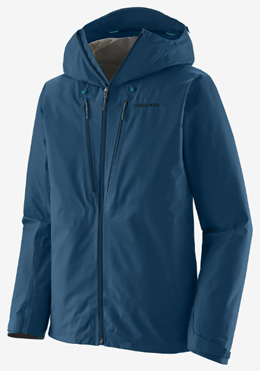
Image: patagonia.com
Check it out at Patagonia.com
The men’s Triolet Jacket is built to endure harsh, snowy conditions. Constructed from a 3-layer GORE-TEX fabric that is waterproof, breathable, and windproof, it features a 100% recycled polyester exterior for enhanced resilience.
This jacket is PFC-free and is made in a Fair Trade-certified facility. It includes a helmet-compatible hood, two chest pockets with watertight zips, two front pockets, and an interior pocket. It comes with watertight two-way pit zips for added ventilation and a dual-adjust drawcord hem to block out the elements.
The jacket also has a concealed RECCO® reflector for enhanced safety and is made in Vietnam.
Patagonia Terravia 28L Pack
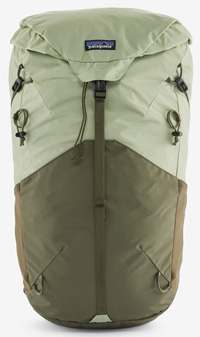
Image: patagonia.com
Check it out at Patagonia.com
The Terravia 28L Pack by Patagonia is a versatile piece of gear suitable for day trips or slightly longer hikes. With a 28-liter capacity and durable 100% recycled nylon construction, it offers strength and sustainability.
The backpack comes with a breathable back panel and shoulder straps, a front-loading pocket, and an automatic lid closure. Its suspended mesh back panel design promotes airflow and moisture control. The Regulator® airmesh shoulder straps and hip belt ensure a comfortable fit.
The Terravia also comes with accessible side pockets, hydration compatibility, a rain cover, and zippered lid and internal security pockets for safe storage of your objects.
Prices
Patagonia is regarded as a premium name within the outdoor enthusiast circle. Their jackets’ prices start at around $130 and reach $700, while their backpacks cost between $70 and $300.
Are Patagonia products worth the price?
In our opinion, Patagonia’s clothing and outdoor gear are worth it. The company is dedicated to using eco-friendly materials, advocating for environmental conservation, and delivering durable, high-quality products. If a jacket can last you for many years, we think the initial investment is justified.
Learn more: Why Is Patagonia So Expensive and Popular? Are Its Jackets Worth It?
3. Which is Better? Norrøna or Patagonia?
Both are great brands with premium products. It obviously comes down to personal preference and budget, but here are some considerations to help with your final decision:
Design and style: Norrøna has a more Scandinavian and European aesthetic that some may find more stylish. Norrøna also offers many vibrant and colorful designs. Patagonia has a more casual, outdoorsy style.
Materials: Norrøna tends to use high-tech, waterproof, breathable fabrics and materials like Gore-Tex, PrimaLoft, etc. Patagonia is also known for innovative fabrics and has its own H2No range of waterproof/breathable fabrics. Both use recycled fabrics as much as possible.
Fit: Norrøna tends to fit more athletic. Patagonia offers a wider range of fits.
Price: Norrøna is more expensive on average. Patagonia is also expensive but offers more options at mid-range prices. Norrøna jackets can reach more than $1000, for example.
Sustainability: Patagonia is considered a leader in corporate social responsibility, using recycled materials and advocating for the environment. Norrøna is also eco-friendly but not as vocal.
Warranty (At the time of writing): Patagonia has its famous Ironclad Guarantee. Norrøna offers a 5-year warranty on production and material defects.
In the end, Norrøna is excellent for technical mountain pursuits while Patagonia has a broader appeal for casual outdoor activities while also offering high-performance pieces. But, you can’t go wrong with either of these brands.
Let us know what you think in the comments section below.
Read next: Mammut vs Patagonia Outdoor Gear: Which is Better?
